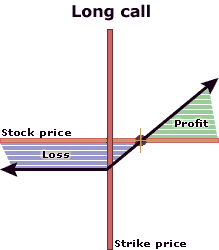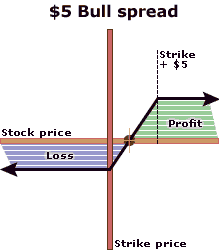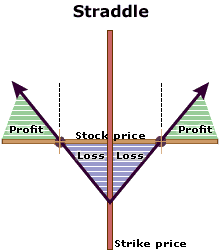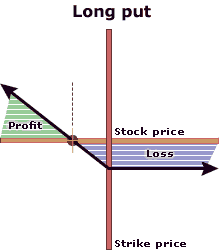Introduction
You may have heard of options and seen that you can trade them in your online account, but what is a stock option and why would you even care if one exists?
Let's start first with a very basic question: What is a stock option?
A stock option is not a physical thing like holding shares in a company. Instead it is a contract between two parties.
When you own stock (or shares) you actually own part of a physical entity--a piece of a company. An option is an agreement, or contract, where one party agrees to deliver something to another party within a specific time period and for a specific price.
This distinction is important because with options you are not borrowing anything. For example, in the case of stock, you must first borrow the stock to short it--but with options there is nothing to borrow so you can short options without the worry of borrowing first.
Options are popular because they can help you get more bang for your buck. Instead of buying a stock outright, you can enter into an options contract which can be much cheaper but have the same--or even better--results.
Options can also be less risky than holding stocks, but that is not always the case. If you plan on trading options at some point make sure you understand fully the risk and downside of each trade. Also, options take more attention and can amplify the movement of a stock in your favor or out of your favor very quickly. So options trading is not for everyone, especially if you are not comfortable taking on risk or managing positions.
Learning about options isn't difficult anymore. There are a few web sites that have popped up recently to help you keep track of options news. And there have been plenty of books written recently that can really help individual investors understand how using options can be a worthwhile endeavor, depending on your financial needs.
Many of the various options exchanges have web sites geared towards individual investors looking for information on options.
Probably the best prepared to reach investors is the Chicago Board Options Exchange, which has a terrific web site set up to educate you. Visit its education page. The CBOE also holds seminars and sells books about options and how to trade them.
Your broker also can give you much guidance if you are prepared to trade options online or through a proprietary service.
Bull strategies
If you are trying to make money on a stock that you think will go up, you may adopt a bull spread strategy (hence the name).
This trading strategy can be accomplished with either puts or calls.
Remember a call is the right (not obligation) to purchase a security (stock, index, or bond) at a specific price on or by a specific date. A put is the right (not obligation) to sell a security (stock, index, or bond) at a specific price on or by a specific date. See Options terms.
NAKED LONG CALL
The simplest bullish strategy is the naked long call (see chart below). This is simply buying the call without any type of hedge and the strategy is used when you think that a security is going to make a large move upward.
|
Let us assume that a stock is trading $50. You may purchase a call with a strike price of 50 and about 30 days until that option expires. This call may costs $4, for example.
If the stock closes $50 or less on expiration then the call will expire worthless. This represents your maximum risk. There is no way to lose more than you paid for the call. If the stock closes at some price higher you will begin to recoup some of your investment and possibly make money.
If the stock closes at $54 on expiration, you will exercise your right to purchase the stock at $50 and immediately turn around and sell the stock for $54 yielding $4. Since this profit covers your initial investment, however, the outcome is a net wash.
This point is important since it is your breakeven point. It is always important to know your breakeven point PRIOR to making any options trade. By knowing this point you also know where you are loosing money but more importantly where you are making money.
Now comes the good part. If the stock closes above $54 you will be making a net profit. Let us say the stock closes $60 on expiration. There are two ways to take profits: The first is to exercise the right to purchase the stock at $50 and then turn around and sell it for $60 yielding a $6 profit. But you have to have enough money in your account to take delivery of the stock.
Another way to take a profit, and the better way of doing it, is to sell the option the Friday of expiration for $10. This $10 is referred to as the par value of the option. Math is: $10 minus the $4 you paid for it yields $6 in profit. (Note that you may actually be able to sell it for 10 1/8 or have to sell it for 9 7/8 depending on how volatile the stock is, or how liquid those particular options are that day.)
$5 BULL SPREAD
Lets talk about bull spreads. Bull spreads also take advantage of an upward movement of a stock, but they are less risky. And unfortunately if the stock makes a very large movement to the upside, then you are also limiting your reward by using this strategy
|
But let's assume that a stock is trading for $50. If you are bullish, you may choose to buy the 50-55 call spread.
What does this mean? This means that you are purchasing the 50 level calls and selling the 55 level calls. Since the 50 level calls are more expensive than the 55 level calls, this spread is done for a net debit.
Remember our previous example. The 50 level calls were trading for $4. Let us say that the 55 level calls are trading for $2. This means that you can buy the 50-55 call spread for $2 ($4-$2).
This call spread is a $5 call spread since the strikes of the two options involved are $5 apart. This means that at expiration (when the options expire) the most the call spread can be worth is $5 and the least the spread can be worth is $0.
Let us take a look at two extreme examples.
First lets assume that the stock goes to $100. The 50 level call that you own will be worth $50 however, you will have to pay out $45 on the 55 level call that you are short ($50 - $45 = $5). This means that your profit is $5 minus the $2 that you paid for the spread that is $3.
Another example is what would happen if the stock dropped to $5. Both of the calls will be worthless since they will both be out of the money. Therefore your loss is $2, the amount that you paid for the spread.
Remember, if you paid $2 for the spread the most that you could hope to make is $3. Here's the math: $5 is the most that the spread can be worth, minus $2 which is what you probably paid for it.
It is also possible to do $10 call spreads or $15 call spread, but those spreads will cost more to do since the possible reward is greater however, they work pretty much the same way.
BULL SPREADS WITH PUTS
Bull spreads can also be done with puts.
If you sell the 50 – 55 put spread the result is identical to the example above. Lets say that the 55 put is trading for $7 and the 50 level put is trading for $4. (Notice that the 50 level put and call are the same price, this is true close to expiration with the stock trading at the strike.) If you sell the 55 level put and you buy the 50 level put then you have sold the put spread for a net credit of $3 to you.
Let’s once again use the same extreme examples of stock movement. First with the stock trading $100 both of the puts are worthless and therefore your profit is the $3 you got for selling the spread. If the stock goes all the way down to $5 the 55 level puts are worth $50 and the 50 level puts are worth $45, meaning the spread is worth $5.
Since you are short the spread you must pay out the $5 but since you sold the spread for $3 you are really only out $2.
STRADDLES
Straddles are a fun to look, but are complicated and difficult to take advantage of. They are kind of like chess… a day to learn but a lifetime to master. But let's discuss it nonetheless
Straddles are when you buy both the put and call of the same strike of the same month. They work when you think that a stock is going to make a very large move EITHER to the upside or to the downside.
|
Let’s keep using the same options that we have been talking about in the previous examples. To put on a straddle we would have to buy the 50 level call for $4 and the 50 level put for $4. This means that we have just paid an $8 debit for the straddle.
As you can see from the chart and as you have probably guessed, your maximum loss occurs at $50 where you loose all $8.
The breakeven points are at $58 and $42. At $58 the put is worthless and the call is worth $8. At $42, the call is worthless and the put is worth $8. Therefore, you do not make anything unless the stock makes a 16 percent move ($8). This is a huge move. To make $8 the stock must move either to $66 or down to $34 a 32 percent move.
Here’s the problem: If the stock goes up to $66 and closes at expiration at $58 then all you do is break even. The same is true if the stock goes to $34 and closes $42.
Let’s say the stock goes to $66 and you sell the call out for $17 ($1 for premium). And then the stock goes back down, you have locked in your profit of $9 ($17-$8) and still own a free put till expiration. This is also possible to the downside.
However, this requires that you are constantly paying attention to your stock and you will also incur additional commissions. Diligence and patience can pay off though.
Bear strategies
If you are trying to make money on a stock that you think will go down, you may adopt a bear spread strategy (hence the name).
This trading strategy can be accomplished with either puts or calls.
Remember a call is the right (but not the obligation) to purchase a security (stock, index, or bond) at a specific price on or by a specific date. A put is the right (not obligation) to sell a security (stock, index, or bond) at a specific price on or by a specific date. See Options terms.
NAKED LONG PUT
The simplest bear strategy is the naked long put. This is done by simply buying the put without any type of hedge. This strategy is used when you think that a security is going to make a large move downward.
|
Let us assume that a stock is trading for $50. You may purchase a put with a strike price of 50 and about 30 days till expiration. Let us say that this put costs you $4. If the stock closes at $50 or more on expiration then the put will expire worthless.
This represents your maximum risk. There is no way to lose more than you paid for the put. If the stock closes at some price lower you will begin to recoup some of your investment and possibly make money.
If the stock closes $46 at expiration, you will exercise you right to sell the stock at $50 and immediately turn around and buy the stock for $46 yielding $4. But since this profit covers your initial investment the outcome is a net wash.
This point is important since it is your breakeven point. It is always important to know your breakeven point PRIOR to making any options trade. By knowing this point you also know where you are loosing money but more importantly where you are making money.
Now comes the good part. If the stock closes below $46 you will be making a net profit. Let us say the stock closes $40 on expiration. There are two ways to take profits. The first is to exercise the right to sell the stock at $50 and then turn around and buy it for $40 yielding a $6 profit.
But taking profits this way means you must have enough money in your account to cover the stock.
Another way to take profits is to sell the option the Friday of expiration for $10. This $10 is referred to as the par value of the option. Math is: $10 minus the $4 you paid for it yields $6 in profit. (You may actually have to sell it for 10 1/8 or have to sell it for 9 7/8 depending on how volatile the stock is, or how liquid those particular options are that day.)
$5 BEAR SPREAD
Lets talk about bear spreads. Bear spreads also take advantage of an downward movement of a stock but are less risky than the naked long put. However, if the stock makes a very large movement to the downside then you are also limiting your reward.
|
Let's assume that a stock is trading for $50. If you are bearish, you may choose to buy the 50-45 put spread. What does this mean? This means that you are purchasing the 50 level puts and selling the 45 level puts.
Since the 50 level puts are more expensive than the 45 level puts, this spread is done for a net debit. Remember our previous example? The 50 level puts were trading for $4. Let us say that the 45 level puts are trading for $2. This means that you can buy the 50-45 put spread for $2 ($4-$2).
This put spread is called a $5 put spread since the strikes of the two options involved are $5 apart. This means that at expiration (when the options expire) the most the put spread can be worth is $5 and the least the spread can be worth is $0.
Let us take a look at two extreme examples. First lets assume that the stock goes to $1. In this case, the 50 level put that you own will be worth $49 however, you will have to pay out $44 on the 55 level put that you are short ($49 - $44 = $5).
This means that your profit is $5 minus the $2 that you paid for the spread or $3.
Our second example is if the stock is trading at $100. Both of the puts will be worthless since they will both be out-of-the-money (see options terms). Therefore your loss is $2, or the amount that you paid for the spread.
BEAR SPREADS WITH CALLS
Bear spreads can also be done with calls.
If you sell the 45–50 call spread the result is identical. Lets say that the 45 call is trading for $7 and the 50 level call is trading for $4. (Notice that the 50 level put and call are the same price, this is true close to expiration with the stock trading at the strike.) If you sell the 45 level call and you buy the 50 level call, then you have sold the put spread for a net credit of $3 to you.
Let’s once again use the same extreme examples of stock movement.
First with the stock trading $1 both of the calls are worthless and therefore your profit is the $3 you got for selling the spread. If the stock goes to $100 the 45 level calls are worth $55 and the 50 level calls are worth $50 meaning the spread is worth $5.
Since you are short the spread you must pay out the $5 but since you sold the spread for $3 you are really only out $2.
STRADDLES
Straddles are a fun to look, but are complicated and difficult to take advantage of. They are kind of like chess… a day to learn but a lifetime to master. But let's discuss it nonetheless.
Straddles are when you buy both the put and call of the same strike of the same month. They work when you think that a stock is going to make a very large move EITHER to the upside or to the downside.
|
Let’s keep using the same options that we have been talking about in the previous examples. To put on a straddle we would have to buy the 50 level call for $4 and the 50 level put for $4. This means that we have just paid an $8 debit for the straddle.
As you can see from the chart and as you have probably guessed, your maximum loss occurs at $50 where you lose all $8.
The breakeven points are at $58 and $42. At $58 the put is worthless and the call is worth $8. At $42, the call is worthless and the put is worth $8. Therefore, you do not make anything unless the stock makes a 16 percent move ($8). This is a huge move. To make $8 the stock must move either to $66 or down to $34 a 32 percent move.
Here’s the problem: If the stock goes up to $66 and closes at expiration at $58 then all you do is break even. The same is true if the stock goes to $34 and closes $42.
Let’s say the stock goes to $66 and you sell the call out for $17 ($1 for premium). And then the stock goes back down, you have locked in your profit of $9 ($17-$8) and still own a free put till expiration. This is also possible to the downside.
However, this requires that you are constantly paying attention to your stock and you will also incur additional commissions. Diligence and patience can pay off though.
Options terms
Expiration: The final day of the contract that the option must be either exercised or expire worthless. For standard listed options this is the Saturday following the third Friday of the month of expirations. Brokerage firms require that you let them know by 2:30pm PST the Friday before. Most of the time in-the-money options are automatically exercised.
In-the-money: For calls this means that the strike price of the option is less than the price of the stock. For puts this means that the strike price is greater than the price of the stock. All in-the-money options are usually exercised on expiration automatically. Check with your brokerage firm to be sure.
Out-of-the-money: For calls this means that the strike price is greater than the price of the stock. For puts this means that the strike price is less than the price of the stock. Out-of-the-money options are almost never exercised.
At-the-money: For both puts and calls, the strike price is the same or close to the price of the stock. i.e. if the stock is trading 56 1/2, the 55 level puts and calls are referred to as the at-the-money-options.
Premium: The value of the option that is not intrinsic. Out-of-the-money options are all premium. Premium is sometimes referred to as time value. Premium generally goes down as expiration approaches. Also referred to as "juice".
Juice: see Premium.
Time Value: see Premium.
Theta: The daily amount of decrease of options value due to advancement of time. Also referred to as decay.
Decay: See Theta.
Vertical Spread: Any spread strategy that employs multiple options (all puts or all calls) in the same month. i.e. Butterflys, bull, bear, Christmas tree, condor.
Time Spread: When you buy an option in one month and sell an option to hedge in another month.
Straddle: When you either by or sell a put and a call of the same strike and same month.
Strangle: When you either buy or sell a put and call of different strike and the same month
American options: Options that may be executed any time until expiration. This is the most common type of option.
European options: Options that may only be executed at expiration.
Types of orders
GTC: Good till cancelled. The order is valid until it is either executed or it is cancelled.
Day: The order is valid until the end of the trading day or it is cancelled.
AON: All or none-- The entire order must be executed at once or it is not valid.
OCO: One cancels the other-- When two orders are entered at the same time, only one of the orders may be executed. As soon as one of the two is executed the other is cancelled.
IOC: Immediate or cancel-- The order must be executed immediately or it is cancelled.
Limit: The maximum a customer will pay to execute the order.
Market: The customer will pay the best offer to execute the order irregardless of the price.




